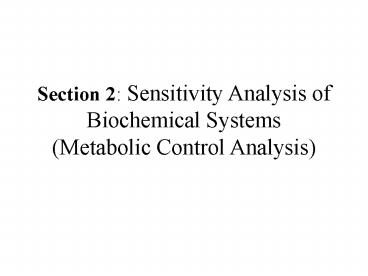Sensitivity Analysis of Biochemical Systems: Metabolic Control Analysis PowerPoint PPT Presentation
1 / 27
Title: Sensitivity Analysis of Biochemical Systems: Metabolic Control Analysis
1
Section 2 Sensitivity Analysis of Biochemical
Systems (Metabolic Control Analysis)
2
Metabolic Control Analysis (MCA)
Parameters 1. Enzyme Levels 2. Kinetics
Constants 3. Boundary Conditions
Variables 1. Concentrations of Molecular
Species 2. Fluxes
MCA investigates the relationship between the
variables and parameters in a biochemical network.
3
Biochemical Systems
Stoichiometry Matrix
4
Biochemical Systems
Rates
5
Biochemical Systems
System dynamics
6
Steady State
7
Steady State Sensitivity
Slope of secant describes rate of change (i.e.
sensitivity) of s1 with respect to p1
As ?p1 tends to zero, the secant tends to the
tangent, whose slope is the derivative of s1 with
respect to p1, measuring an instantaneous rate
of change.
8
Steady State Sensitivity
9
MCA Terms
Responses (system sensitivities)
10
MCA Terms
Elasticities (component rate sensitivities)
Control Coefficients (system interconnections)
11
Substrate Elasticities
12
Parameter Elasticities
13
Control Coefficients
By definition (partitioned response properties)
If ?p is diagonal (e.g. pE)
If ?p I
14
Summation Theorem
Let k be in the nullspace of N (i.e. Nk 0)
Interpretation If p is chosen so that ?p is in
the nullspace of N
15
Summation Theorem -- Example
16
Connectivity Theorem
17
Connectivity Theorem -- Example
18
Control Matrix Equation
So
Interpretation The system interconnections can
be determined directly from the component
sensitivities
19
Application of the Control Matrix Equation
20
Adding Negative Feedback
21
The Effect of Negative Feedback
Without feedback
With feedback
22
The Effect of Negative Feedback
Without feedback
With feedback
23
Scaled Sensitivities
measure relative (rather than absolute)
changes -- makes sensitivities
dimensionless -- permits direct comparisons
24
Time-Varying Sensitivities
Sensitivities can be addressed over transient or
oscillatory behaviour
Computation
25
Example
Perturbation in S1(0)
Perturbation in k1
26
Application to Phototransduction Pathway
27
Connections to Control Theory
- Sensitivity analysis (e.g. robustness to
perturbations) - Control Matrix Equation signal flow graph
analysis (Mason, Sen) - Error analysis gap metric (Vinnecombe)

